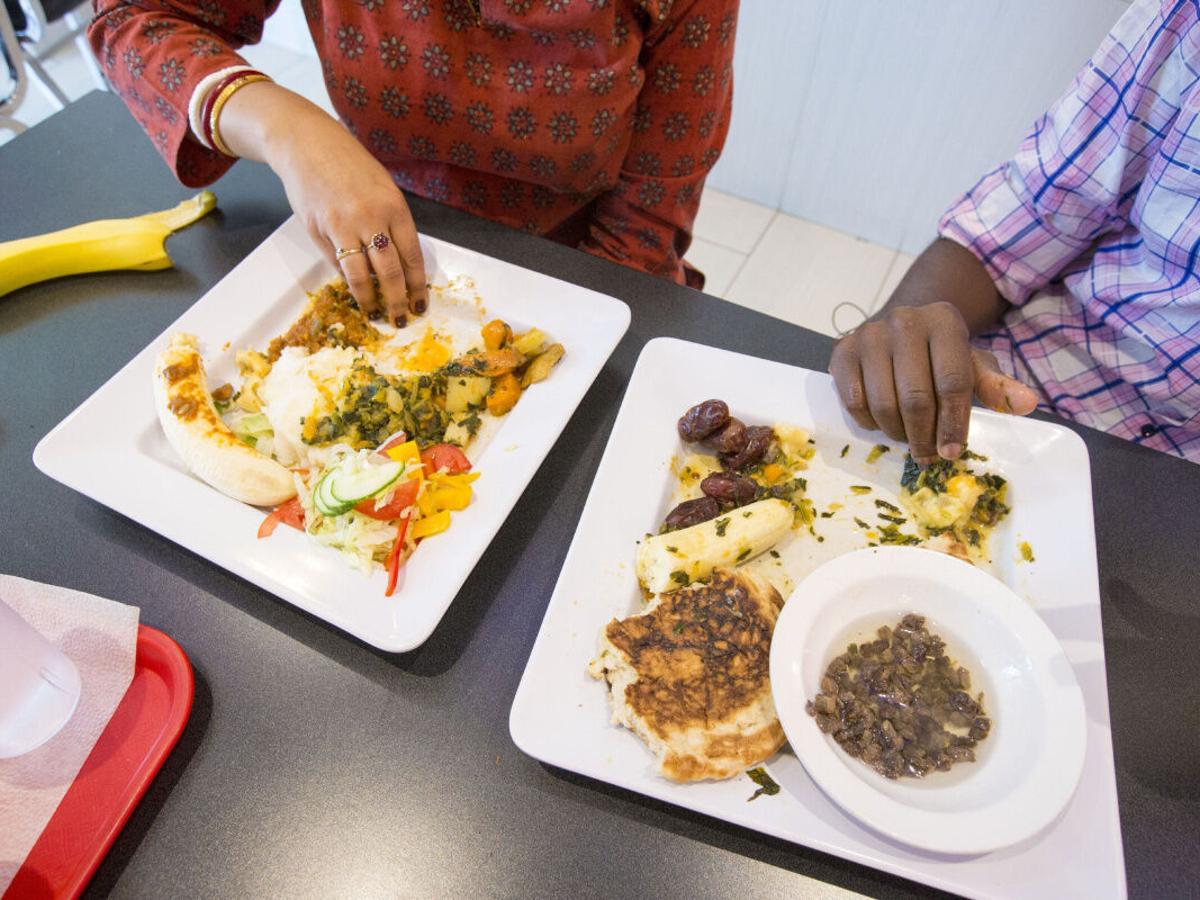Genuine Somali Food: From Flavors to Savory Delights, Study Culinary Bliss
Wiki Article
From Staple Cuisines to Exotic Specializeds: Unwinding the Diverse and Vibrant World of Somali Food

Typical Somali Staples
If you intend to experience genuine Somali food, you should regularly delight in conventional Somali staples. These staples form the foundation of Somali food preparation and showcase the rich social heritage of the Somali people. One such staple is the prominent flatbread referred to as "injera." Made from a fermented batter of teff flour, injera is a functional and necessary part of Somali dishes. It is commonly made use of as an utensil to scoop up sauces and stews, adding a special texture and flavor to each bite.Another staple is "baasto," a tasty pasta dish that is frequently enjoyed in Somali households. Baasto is normally made with spaghetti or linguine noodles, prepared up until tender and then blended with an aromatic sauce made from tomatoes, onions, garlic, and a mix of traditional Somali seasonings (Somali food). This dish is commonly served with a side of maraq, a delightfully spiced broth that adds depth and complexity to the dish
Last but not least, "bariis" or rice is a staple that is deeply embedded in Somali food. Bariis is often prepared with great smelling spices such as cardamom, cinnamon, and cloves, giving it a wonderful aroma and preference. It is frequently served with a selection of meat or veggie stews, producing a rewarding and hearty meal.
Flavors From the Sea: Somali Seafood Delicacies

An additional favorite is Muqmad, a dried out fish meal that is often delighted in as a snack or used as a component in various other recipes. The fish is treated with salt and seasonings, offering it a somewhat tangy and savory taste.
Lahoh with maraq is a standard Somali pancake offered with an abundant seafood stew. The pancake is squishy and soft, while the stew is made with a mix of shellfishes, fish, and veggies, simmered in a delicious brew. This recipe is a true depiction of the seaside flavors found in Somali cuisine.
Whether it's barbequed lobster, spicy shrimp curry, or zesty calamari, Somali seafood specials are a must-try for any kind of seafood enthusiast. The freshness of the ingredients, incorporated with the fragrant seasonings, develop a harmony of tastes that will transfer your preference buds to the coasts of Somalia. Do not miss out on the chance to savor the sea's bountiful prizes when checking out Somali cuisine.
Fragrant natural herbs and exotic spices
Discover the tantalizing range of flavors in Somali cuisine with making use of a remarkable selection of aromatic natural herbs and unique seasonings. Somali food is understood for its lively and strong tastes, and these natural herbs and flavors play a crucial function in creating the unique preference that sets Somali food apart.One of the most commonly used flavors in Somali cooking is cumin. Its earthy and cozy taste adds depth to recipes like rice, stews, and meat prep work. Somali food. Turmeric extract, with its vibrant yellow color and moderate flavor, is one more staple in Somali cuisine. It is utilized to boost the preference and appearance of rice, soups, and meat dishes.
Cardamom, an aromatic spice with a tip of citrus, is additionally commonly made use of in Somali cooking. It adds a aromatic and special touch to both sweet and mouthwatering dishes. Various other preferred seasonings include cinnamon, cloves, and coriander, which are utilized to include heat and complexity to different recipes.
Aromatic herbs like parsley, mint, and cilantro are additionally essential ingredients in Somali cuisine. They are used to garnish recipes, imparting quality and a burst of flavor. These herbs are commonly added to sauces, salads, and meat meals, enhancing the overall preference and fragrance.
With the use of these exotic seasonings and aromatic natural herbs, Somali cuisine offers a genuinely special and alluring eating experience. The combination of tastes develops a harmonious equilibrium that is both satisfying and remarkable. Whether you're enjoying a typical Somali stew or a flavorful rice dish, the natural herbs and flavors used in Somali food preparation make certain to leave a long-term impression on your palate.
Influences From Arab, Indian, and European Cuisines
Arab, Indian, and European cuisines have significantly affected the dynamic and diverse globe of Somali food. Over the centuries, Somalia's tactical area on the Indian Ocean profession routes has enabled a rich exchange of culinary click here for more info and social traditions with bordering Arab and Indian communities, as well as European colonial powers. These communications have actually left a long-term influence on the Somali cooking landscape, resulting in a combination of tastes and strategies that make Somali cuisine absolutely special.
Among one of the most significant influences can be seen in the comprehensive use flavors in Somali food preparation. Arab and Indian flavors such as cumin, coriander, cardamom, cinnamon, and cloves are typically made use of to add deepness and intricacy to Somali recipes. The introduction of these flavors has not only enhanced the flavors however has actually likewise added to the vivid and aromatic nature of Somali food.
European impacts can be traced back to the colonial era when Somalia was under the control of various European powers, including the Portuguese, British, and Italians. These colonial communications brought cooking techniques and brand-new components to Somalia. For example, pasta meals like "baasto" (Somali pasta) and "sabayad" (a Somali flatbread) are clear examples of Italian influence.
Commemorating Food in Somali Society
1. Celebrating food is an important component of Somali culture, where common dishes and cheery celebrations are cherished traditions. Food view website plays a main function in bringing individuals with each other, promoting a feeling of community and connection. Whether it's a wedding, a spiritual vacation, or a simple family members celebration, Somali individuals take enormous satisfaction in their cuisine and utilize it as a way to commemorate and share their cultural identity.visit this website

In enhancement to the delicious food, the act of sharing a dish is deeply purposeful in Somali culture. It signifies friendliness, generosity, and the significance of area. Somali food. Resting down together, often on a floor covering or a communal plate, and breaking bread cultivates a sense of unity and reinforces bonds between friends and family
Moreover, food is additionally a method to keep in mind and recognize enjoyed ones that have died. During unique celebrations, such as the Islamic holiday of Eid al-Fitr, Somalis prepare conventional sugary foods called xalwo as a way of paying tribute to their forefathers and keeping their memory active.
Verdict
In final thought, Somali food offers a diverse and dynamic culinary experience. From standard staples to unique specializeds, the food is abundant in tastes and showcases the country's social impacts. With a selection of fish and shellfish specials, fragrant natural herbs, and seasonings from Arab, Indian, and European cuisines, Somali food is an event of tastes and traditions. Whether you're discovering the staple dishes or venturing into the world of exotic specialties, Somali cuisine is sure to entice your taste buds.If you desire to experience authentic Somali food, you need to regularly indulge in conventional Somali staples.To absolutely submerse yourself in the dynamic and diverse globe of Somali food, you must frequently delight in the splendid flavors of Somali fish and shellfish delicacies. Whether you're delighting in a standard Somali stew or a delicious rice dish, the seasonings and herbs utilized in Somali cooking are certain to leave a lasting perception on your preference buds.
These interactions have left an enduring impact on the Somali culinary landscape, resulting in a combination of flavors and methods that make Somali food absolutely distinct.
Pasta dishes like "baasto" (Somali pasta) and "sabayad" (a Somali flatbread) are clear examples of Italian influence.
Report this wiki page